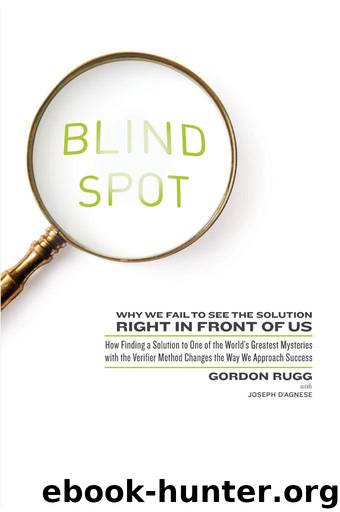Blind Spot: Why We Fail to See the Solution Right in Front of Us by Gordon Rugg

Author:Gordon Rugg [Rugg, Gordon]
Language: eng
Format: mobi
Publisher: HarperCollins
Published: 2013-04-29T14:00:00+00:00
Grilles
If you’re a modern researcher, you’re taught to work systematically. That fact is taken so much for granted that it’s often not mentioned explicitly; it just never occurs to you that anyone could work any other way. It’s a particular issue in cryptography, the field of code making and breaking. If you don’t encode your message systematically, the person at the other end won’t be able to decode it and understand it.
There’s a strong suspicion that this is why the D’Agapeyeff Cipher has never been cracked. Alexander D’Agapeyeff wasn’t an expert cryptographer by background; he wrote a textbook on the subject because his publishers wanted a book about it, and they saw him as a dependable author in his main field, cartography—mapmaking—with enough knowledge of cryptography to write a basic introductory textbook. So it’s plausible that when he produced the now-famous cipher text that bears his name, he made a mistake partway through, leaving the text indecipherable.
So if a modern researcher was looking for a way to mix and match syllables using a table, the automatic reaction would be to look for a way of doing it systematically. The first thing she’d do is reach for the random number generators. That’s not how it would have been done when the manuscript was created, however, because the concept of randomness hadn’t been invented when the manuscript was produced.
One obvious solution—with hindsight, at least—is to use a tool that shows you only three syllables of the table at a time. One such tool is a version of the Cardan grille, the encoding device created by Cardano, whom we met in chapter 6. You take a card with three holes cut in it, each the same size as a cell on your table, and lay it over your table. The three syllables it reveals give you a word to copy onto your own document. By varying the patterns of the holes cut into your card—your grille—you can reuse the same table over and over again, generating new text each time.
Here’s what a couple of examples might look like (figures 26 and 27). The gray cells show where holes would be cut through the card. (See the real ones I used in color figure 5b.) You’d need a lot of these cards, each with a different pattern, to vary the word selection from the same table.
Download
This site does not store any files on its server. We only index and link to content provided by other sites. Please contact the content providers to delete copyright contents if any and email us, we'll remove relevant links or contents immediately.
Tools of Titans by Timothy Ferriss(8147)
Change Your Questions, Change Your Life by Marilee Adams(7556)
Deep Work by Cal Newport(6811)
Man-made Catastrophes and Risk Information Concealment by Dmitry Chernov & Didier Sornette(5873)
Playing to Win_ How Strategy Really Works by A.G. Lafley & Roger L. Martin(5738)
Digital Minimalism by Cal Newport;(5580)
Big Magic: Creative Living Beyond Fear by Elizabeth Gilbert(5550)
The Slight Edge by Jeff Olson(5314)
Ego Is the Enemy by Ryan Holiday(5220)
The Motivation Myth by Jeff Haden(5118)
Stone's Rules by Roger Stone(4986)
The Laws of Human Nature by Robert Greene(4920)
Tuesdays with Morrie by Mitch Albom(4584)
Eat That Frog! by Brian Tracy(4376)
Rising Strong by Brene Brown(4337)
Skin in the Game by Nassim Nicholas Taleb(4121)
The Money Culture by Michael Lewis(4021)
Bullshit Jobs by David Graeber(3988)
Skin in the Game: Hidden Asymmetries in Daily Life by Nassim Nicholas Taleb(3866)
